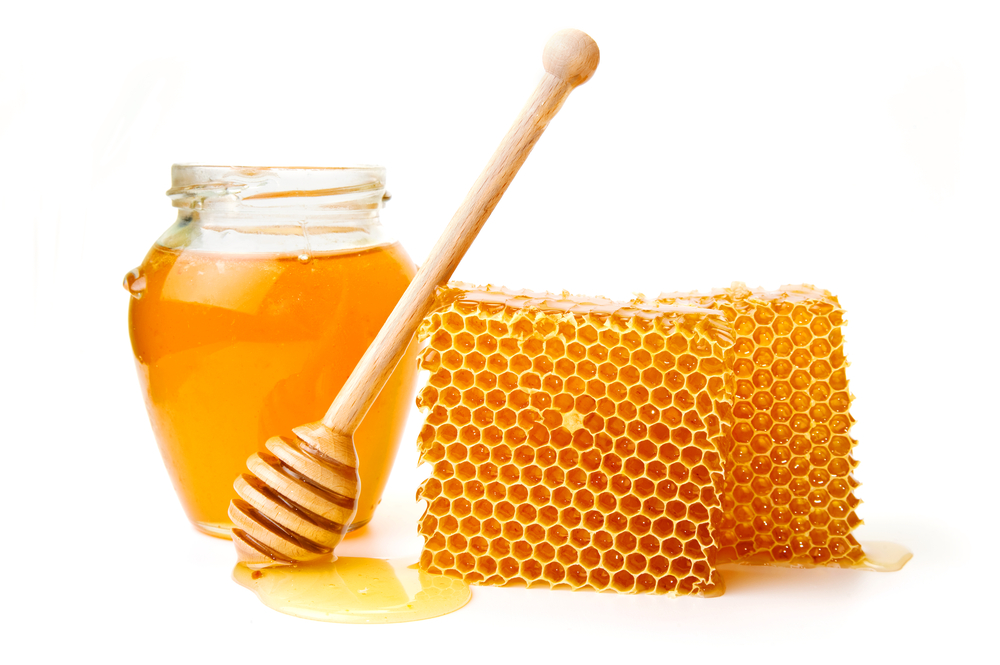Honey has been a documented antibiotic treatment for cultures across the globe for thousands of years, including during the First World War.[1] Doctors and other medical professionals have also increasingly begun to see the benefits of honey for wound care and other purposes. Not only can honey kill bacteria, but it also helps maintain wound moisture and acts as a protective barrier.[2] It also minimizes inflammation and promotes healing in wounds and other skin conditions.[3] By keeping some local or even commercial honey at home, you can use honey as a topical antibiotic for wounds and other skin conditions such as acne.
Applying Honey to Wounds

-
Have the right honey on hand. Although you can use any type of honey to help wounds, some types, such as manuka, may be more effective than others as topical antibiotics. Keeping a supply of honey in your home can ensure you have it when you most need it.[4]
- Be aware that locally-produced honeys are the most effective at killing bacteria. You can also get medical grade honey. You can get these products at health food stores, local markets, and even some grocery stores.
- Be careful when buying commercial honey, which may not be effective at killing bacteria and healing wounds because of unknown additives or origins. Read the label and make sure that commercial honeys are pure, pasteurized honey.[5]
-
 2
2Clean the wound. You’ll need to clean the wound and remove any superficial debris from the wound before applying honey. This helps clear bacteria and minimizes the risk of infection.[6]
- Wash the wound gently and thoroughly with warm water and soap. You don’t need any special product for cleansing. All soaps are equally effective at washing away dirt and debris.[7] Rinse the wound until you see no soap residue or superficial dirt and debris.[8]
- Dry the wound completely with a clean towel or washcloth.
- Avoid removing any deeply-embedded debris because can spread bacteria and promote infection.[9] Instead, see your doctor to have this type of debris removed.
-
 3
3Apply a bandage with honey. Once your wound is clean and dry, you’re ready to apply the honey. Spread a layer of honey on a bandage and place it on the wound to help protect it and kill bacteria.
- Drizzle the honey on one side of a clean bandage, piece of gauze, or cloth. Then place the surface of the side with honey against the wound.[10] Make sure it covers an area that is wider than the wound to kill bacteria in surrounding tissues.[11] Avoid pushing the bandage on to the wound. Instead, gently press or dab it on and around the wound to ensure the honey comes in contact with your skin.
- Seal the bandage with surgical tape. You can also use options like duct tape if you’re in a pinch.[12]
-
 4
4Pour honey on the wound. If you prefer, you can pour the honey directly on to the wound. This method may help you more effectively ensure that honey comes in contact with the wound.
- Spread or drizzle a thin film of honey on the wound with a clean finger, cotton swab, or cloth. If you want, you can measure out 15 to 30ml of honey and pour that directly on the wound.[13] Make sure to spread the honey beyond the borders of the wound to kill bacteria int he surrounding tissues.[14] Cover it with a clean bandage and then seal it with surgical or even duct tape.[15]
-
 5
5Repeat the process. In most cases, you’ll need to reapply honey to your wound every 12 to 48 hours depending on the severity and how quickly it heals. Cleanse the wound and apply the honey as often as necessary until the wound heals. Make sure to consult your doctor if the wound isn’t healing or shows signs of infection, such as redness, warmth, tenderness, pus, or red streaks.[16]r
- Inspect the wound at least every two days to make sure it isn’t infected. Make sure your hands are clean and consider putting a clean bandage on the wound any time you inspect it.
Treating Other Conditions with Honey
-
 1Soothe burns with honey. If you have a burn from any type of accident or from a sunburn, honey can soothe the burn and promote rapid healing. For burns, it is more effective to place the honey on a bandage or cloth and then place it directly on the burn. Make sure to seal it with surgical or duct tape and check the wound on a regular basis.[17]
1Soothe burns with honey. If you have a burn from any type of accident or from a sunburn, honey can soothe the burn and promote rapid healing. For burns, it is more effective to place the honey on a bandage or cloth and then place it directly on the burn. Make sure to seal it with surgical or duct tape and check the wound on a regular basis.[17] -
 2
2Get rid of acne. Honey naturally moisturizes the skin and can kill bacteria that causes acne. Spreading a thin layer on your skin or preparing a mask may treat and prevent acne and keep your skin glowing.
- Spread a layer of warmed honey on your face. Leave it on for 10 to 15 minutes and then rinse with lukewarm water.
- Mix a tablespoon of honey with a teaspoon of baking soda. Gently rub on your skin to gently exfoliate, purify, and moisturize it.[18] A mixture of two teaspoons of honey and one teaspoon of fresh lemon can also kill acne-causing bacteria.[19]
-
 3
3Reduce skin nodules. Some people develop skin nodules, which are clusters of tissue that appear on different parts of the body. If you have or are prone to nodules, applying a mask of honey may help dissolve them.
- Prepare a mask of honey to help shrink nodules. Mix one teaspoon honey with any one of the following ingredients: lemon juice, avocado, coconut oil, egg white, or yogurt.[20]
- Leave the mask on for a few minutes and then rinse it off completely with warm water.
-
 4
4Kill fungal infections. Honey may also be effective at killing fungal infections of the skin. You can either apply honey directly to affected area or putting some on a bandage and placing that over the infection.[21] Try honey on the following fungal infections:
- Ringworm, also called tinea
- Athlete’s foot.
- Seborrheic dermatitis.
-
 5
5Ease dandruff. There is also evidence that honey can relieve dandruff and its more chronic counterpart, seborrheic dermatitis.[22] Consider regular application of honey to patches of dandruff to relieve dandruff and keep it from relapsing.[23]
- Mix a solution of 90% honey to 10% water and rub it on to areas with dandruff for two or three minutes. Leave the mixture on for three hours and then rinse it off with warm water. Repeat this process daily for two weeks or until you see results.
- Continue application once a week to help prevent relapse of dandruff.
-
 6
6Relieve pruritis. Allergic rashes, psoriasis, or dermatitis can cause itchy skin, or pruritus.[24] This condition can cause pain and irritation of your skin and may be worse at night. However, applying honey to affected areas may help relieve pruritis and prevent infection at the site of the condition.
- Spread a thin layer of honey on itchy skin. You can either cover it or leave it open. However, you may want to cover it if you are wearing clothes or in bed to prevent it from sticking to fabric.
Source: www.wikihow.com




